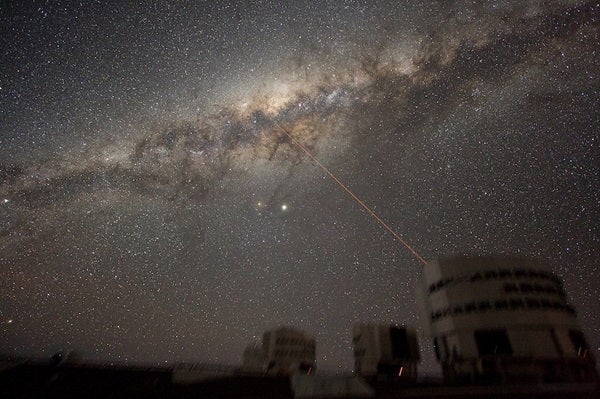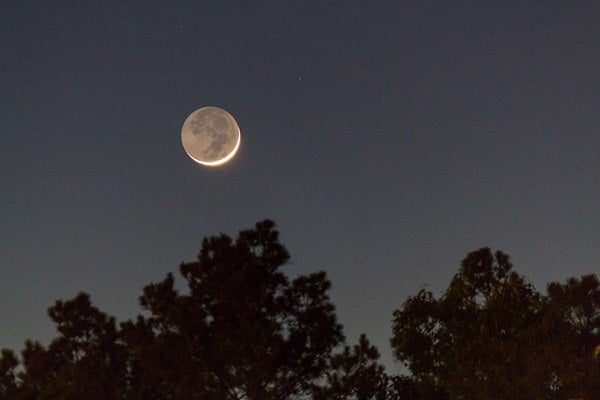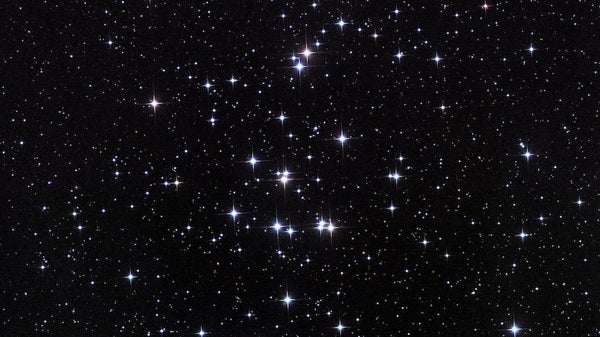These next few days provide the last opportunities this year for observers at mid-northern latitudes to get good views of the zodiacal light after sunset. From the Northern Hemisphere, late winter and early spring are the best times to observe this elusive glow after sunset. It appears slightly fainter than the Milky Way, so you’ll need a clear moonless sky and an observing site located far from the city. But a waxing Moon returns to the after-dusk sky starting March 19, and it will wipe out the zodiacal light. Look for a cone-shaped glow, which has a broad base and points nearly straight up from the western horizon, after the last vestiges of twilight have faded away.
Saturday, March 17
Mercury reached greatest elongation just two days ago, and it remains near the peak of this year’s best evening apparition for Northern Hemisphere observers. The innermost planet stands 11° high in the west a half-hour after sunset this evening. It shines at magnitude 0.1 and shows up well against the darkening sky. But the easiest way to find it is to locate brilliant Venus and then look 4° due north (upper right). The two inner planets fit nicely in a single binocular field of view. A view of Mercury through a telescope reveals an 8″-diameter disk that appears one-third lit. (Venus spans 10″ and is nearly full.)
New Moon occurs at 9:12 a.m. EDT. At its New phase, the Moon crosses the sky with the Sun and so remains hidden in our star’s glare.
Sunday, March 18
With an age of 4.5 billion years, “young” might not seem an appropriate word to describe our Moon. But tonight, you have an exceptional opportunity to see what astronomers call a “young Moon” — a slender crescent visible in the early evening sky. With New Moon having occurred yesterday morning, only 2 percent of our satellite’s disk appears illuminated after sunset tonight. It forms a spectacular trio with Venus 4° to its right and Mercury 4° farther away. You should notice an ashen light faintly illuminating the Moon’s dark side. This is “earthshine,” sunlight reflected by Earth that reaches the Moon and then reflects back to our waiting eyes.
Mars rises a bit before 3 a.m. local daylight time and appears about 25° high in the south-southeast as twilight starts to paint the sky. The magnitude 0.5 Red Planet lies against the backdrop of western Sagittarius. This morning, it has a spectacular encounter with two of the Archer’s finest deep-sky objects when it passes midway between the Lagoon Nebula (M8) and Trifid Nebula (M20). The three objects present a stunning scene through binoculars and telescopes with a wide field of view, and they offer a prime photo opportunity. Mars spans 8″ when viewed through a telescope and should show a few subtle surface details.
Tuesday, March 20
For those of you tired of winter weather, good news: Spring officially begins today. Earth’s vernal equinox occurs at 12:15 p.m. EDT, which marks the moment when the Sun crosses the celestial equator traveling north. The Sun rises due east and sets due west today. If the Sun were a point of light and Earth had no atmosphere, everyone would get 12 hours of sunlight and 12 hours of darkness. But our blanket of air and the finite size of our star make today a few minutes longer than 12 hours.
Wednesday, March 21
One of the spring sky’s finest deep-sky objects, the Beehive star cluster (M44) in the constellation Cancer the Crab, lies high in the south after darkness falls. With naked eyes under a dark sky, you should be able to spot this star group as a faint cloud. But the Beehive explodes into dozens of stars through binoculars or a small telescope.
This evening, the waxing Moon sits on the eastern edge of the Hyades star cluster in Taurus the Bull. The 32-percent-lit crescent lies just above 1st-magnitude Aldebaran, the orange sun that marks the upper left corner of the V-shaped Hyades. In reality, however, the star is a foreground object that only appears along the same line of sight as the cluster.
Friday, March 23
Saturn rises around 3 a.m. local daylight time and climbs some 25° high in the southeast by the time morning twilight begins. The ringed planet shines at magnitude 0.5 and lies in northern Sagittarius the Archer, some 5° east of similarly bright Mars. When viewed through a telescope, Saturn shows a 16″-diameter disk surrounded by a stunning ring system that spans 37″ and tilts 26° to our line of sight.
Saturday, March 24
First Quarter Moon arrives at 11:35 a.m. EDT. Although our satellite rises around noon local daylight time, it becomes much more prominent as darkness falls. It then lies due south and nearly 70° above the horizon. The Moon spends the night at the feet of Gemini the Twins, above the more familiar shape of Orion the Hunter, and sets around 3 a.m. local daylight time.
Sunday, March 25
Head outside during the morning hours and you can’t miss Jupiter. The giant planet rises around 11 p.m. local daylight time and climbs highest in the south around 4 a.m. Jupiter shines at magnitude –2.3, which makes it the brightest point of light in the predawn sky, and resides among the much dimmer stars of the constellation Libra. A telescope reveals the planet’s 42″-diameter disk and four bright moons. This morning, all four satellites line up west of the gas giant.












